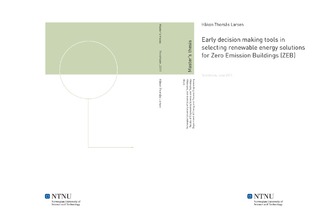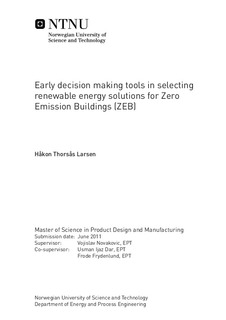| dc.contributor.advisor | Novakovic, Vojislav | nb_NO |
| dc.contributor.advisor | Dar, Usman Ijaz | nb_NO |
| dc.contributor.advisor | Frydenlund, Frode | nb_NO |
| dc.contributor.author | Larsen, Håkon Thorsås | nb_NO |
| dc.date.accessioned | 2014-12-19T11:46:35Z | |
| dc.date.available | 2014-12-19T11:46:35Z | |
| dc.date.created | 2011-09-08 | nb_NO |
| dc.date.issued | 2011 | nb_NO |
| dc.identifier | 439583 | nb_NO |
| dc.identifier | ntnudaim:6283 | nb_NO |
| dc.identifier.uri | http://hdl.handle.net/11250/234324 | |
| dc.description.abstract | The current residential building stock in Norway is organized in to groups, and sorted after number of building units. The criteria used for sorting, are criteria that affect the viability and rationality of various energy supply systems. The results from this survey forms a database where it is possible to go in and find the number of buildings sorted after region, building type, urbanity and year of construction.Based on findings from the survey and other factors affecting the applicability, a set of four energy supply systems are introduced and studied closer as possible solutions in ZEBs; District heating (DH) + PV, Bio energy (BIO) + PV, Heat pump (HP) + PV, Combined heat and power (CHP) + PV. The Zero Emission Building balance is calculated for each solution and pre-defined energy level, to determine the required on-site electricity generation from the PV s. A model is then developed to study the potential of the proposed solutions in the Norwegian residential building stock. The analysis is performed on future scenarios, which represent different development of the building stock with regards to new buildings, refurbishment and demolition. The number of buildings that can be converted to ZEBs with the investigated energy supply systems and [available roof area/floor area] are quantified. Results show uptake potential for all of the technologies in buildings with energy demand lower than 94,5 kWh/m2year, but limitations occur as soon as [available roof area/floor area] decreases from the upper limit investigated in the study (1:2). The greatest potential is shown by CHP + PV, where ZEB conversion is possible in approximately 30% of the total residential stock in year 2050. It is also observed a relative growth in the potential of DH + PV and HP + PV in small houses after year 2025 due to the estimated upgrade of energy-efficiency in the stock. In multi dwelling buildings, it is only CHP + PV and BIO + PV that show potential in both current and future stock. | nb_NO |
| dc.language | eng | nb_NO |
| dc.publisher | Institutt for energi- og prosessteknikk | nb_NO |
| dc.subject | ntnudaim:6283 | no_NO |
| dc.subject | MTPROD produktutvikling og produksjon | no_NO |
| dc.subject | Energi-, prosess- og strømningsteknikk | no_NO |
| dc.title | Early decision making tools in selecting renewable energy solutions for Zero Emission Buildings (ZEB) | nb_NO |
| dc.type | Master thesis | nb_NO |
| dc.source.pagenumber | 81 | nb_NO |
| dc.contributor.department | Norges teknisk-naturvitenskapelige universitet, Fakultet for ingeniørvitenskap og teknologi, Institutt for energi- og prosessteknikk | nb_NO |

